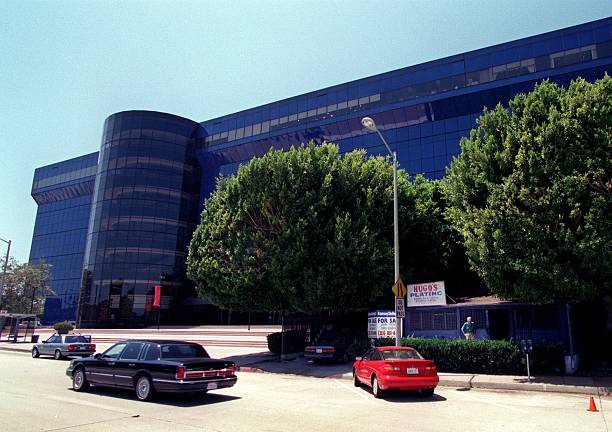
One of the more famous real estate holdouts began in the early 1970s when developers of the landmark Pacific Design Center were assembling property to build the West’s largest interior design and home decoration showplace. The saga wouldn’t end until some 25 years later and at considerable expense to the center.
Everything developers encountered fits the definition of a classic holdout, according to the Los Angeles Times. “Holdouts are easy to spot. They are homes and small businesses overshadowed by larger developments, obviously redesigned to straddle the one small parcel a builder couldn’t acquire.”
Most of the land at the northeast corner of Melrose Avenue and San Vicente where the 750,000 square foot “Blue Whale” would be built was once a railyard. Developers needed to buy a strip along Melrose consisting of a few small retail shops, a lumber yard, an antiques store and a metal-plating business to complete property acquisition.
Everybody agreed to sell – except for the owners of the metal-plating shop. Despite what PDC officials called repeated, generous offers, the pair of sisters who owned the 900 square foot cottage refused to sell their small parcel.
Design Center officials decided to build the project around it. “As a result, the focal point of the center’s entryway became a tarpaper-roofed shack instead of a sleek, landscaped plaza” planned by famed architect Cesar Pelli, the Los Angeles Times reported.
Eventually, in 1998 the cottage’s owners put the property up for sale. A bidding war erupted and the Design Center was forced to pay an astronomical price just to keep anyone else from building something gaudy on the site. The PDC tore down the cottage posthaste and rebuilt the blue building’s parking entryway.
A Shack with a Swanky Address
The decades-long battle was over a shack with a swanky address, by all accounts. The cottage at 8661 Melrose was owned by sisters Emma and Otilia Diaz. They rented the wood frame cottage for several hundred dollars a month to Hugo’s Plating Company, a metal-plating business that refurbished old door handles, light fixtures and other home furnishings. It was run by Hugo Castaneda, who operated the business for 27 years.
“They wouldn’t talk to us,” said Ron Birtcher, the PDC’s lead developer in the early 1970s, about the Diaz family, according to the Times’ 1997 article. “Representatives made repeated efforts during the two-year period to buy the 50-year-old cottage and its 1,750 square foot lot. Birtcher said he no longer remembers the amount being offered, except that it was ‘an enormous amount.’”
“I’m not sure what their rationale was,” he told the newspaper. “Maybe they were holding out for more money. But there never was even a counter-offer. It was a crisis issue to us – we were willing to pay anything.” Finally, Birtcher gave up and decided to build the project without the Diaz family parcel.
Original plans by architect Pelli called for a 530-foot-long “Blue Whale” building set off by sycamore trees and a 350-foot-long planter filled with blooming bougainvillea that would contrast with the glass-sided blue behemoth’s south entrance.
Instead, “Landscapers erected a six-foot fence around (the cottage) and hastily planted a U-shaped line of dense-growing, evergreen ficus trees in hopes of screening it from the Design Center’s chi-chi customers and tenants.”
All sides, meanwhile, settled in for the long haul. Hugo’s Plating became something of a Los Angeles landmark for operating in the shadow of the giant PDC. The tiny firm turned into a humorous symbol of the contrast between the new and the old.
Design Center officials seemed to grow comfortable co-existing with its deliberately downscale neighbor. “It’s kind of a whimsical part of our landscape,” its chief operations officer, Joel Polachek, told the Los Angeles Times.
Selling Time
Finally, the Diaz sisters put their ramshackle cottage up for sale in 1997. Hugo’s Plating Co. had shut down by then, unable to afford a rent increase from $450 to $1,000 monthly. Their asking price of $325,000 was determined by doubling the market value at the time, the real estate broker for the Diaz sisters told the newspaper.
By then, the property seemingly was of little use to anyone other than the PDC. It was surrounded on three sides by the Design Center, plus it lacked the space for on-site parking required of new commercial businesses. Those reasons led PDC officials to believe the parcel would be difficult to sell to an outsider. They took the position that they were no longer anxious to acquire the holdout parcel after struggling in vain in the 1970s to persuade the sisters to sell.
A bidding war changed everything quickly when it was learned that the buyer legally could erect a building 90 feet high on the shack’s 35-foot-deep lot. The Design Center’s bid of $450,000 was accepted, even though the broker for the sisters said offers reached as high as $500,000.
“The specter of someone building something gaudy on the site convinced the center that it was time to bring it into the fold,” according to the Times, Other Melrose Avenue property was selling for $200 per square foot, making the $500-per-square-foot selling price “eye-popping.” And just like that, a parcel many of its neighbors had often called an eyesore became the most expensive piece of property in town.

Fun article, I never knew this was there.
My younger boy always thought of the small, grey building as spooky. Thanks for the memory jog.
Thank you for some history.
Great story.
Interesting read. Thanks.
The PDC was afraid of “someone building something gaudy on the site.” What about the Green Building and the Red Building, not gaudy enough?
The whole complex could have been designed better to improve street life on San Vicente and Melrose.
And if we all were smart enough to buy houses back in the 70’s and hold them we would all be rich!